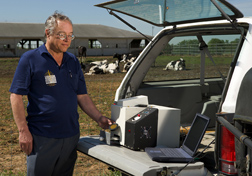Shedding Light on Manure Nutrients
|
|
Agricultural Research Service chemist James Reeves has built a prototype for a manure analyzer that works off a vehicle battery and can be set on a truck’s tailgate.
Manure is one of those “good things” of which it’s sometimes easy to get too much, especially when it’s overapplied to fertilize field crops. Any excess nutrients—nitrogen or phosphorus—can run off in rainwater to eventually pollute streams, lakes, and other bodies of water.
The main reason farmers overapply manure is that they can’t be sure how much nitrogen or phosphorus is in it, so they often err on the side of too much. Currently, their only options are either to guess or to send samples to a lab for analysis, which takes time and money. Usually, they send only one sample from the large pit into which they flush their manure.
“A one-sample analysis can hardly reflect what’s in a manure pit,” says Reeves, “because the nitrogen content varies as the dry matter settles out.” Reeves is at ARS’s Environmental Management and Byproduct Utilization Laboratory at Beltsville, Maryland.
Having access to an accurate, inexpensive manure analyzer will be even more important to farmers if nutrient-management regulations tighten further. With Reeves’s machine, farmers could run the test themselves in a minute or so. The instrument doesn’t require preparation of samples or chemicals to analyze them.
The prototype shines invisible near-infrared light through filters onto about 2 tablespoons of manure placed in a small cup. The amount of light reflected back allows a filter spectrometer to measure both the nitrogen and water content. A disk spins so light can shine through any one of 10 different light filters.
“Farmers need to know manure’s water content to calculate how much nitrogen they’re actually applying,” Reeves says. He’s still working on measuring the phosphorus, which is more difficult to do.
After several years of lab work, Reeves spent the last 2 years collaborating on the analyzer’s design with Fred McClure, a retired professor at the University of North Carolina-Raleigh. Other colleagues helped develop equations needed to calculate nitrogen levels based on light wavelengths.
The prototype machine—a 15-inch cube—weighs about 20 pounds. Reeves says he plans to make it smaller—about the size of a shoebox weighing 5 pounds or less.
“We’d like to get it small enough for users to carry by hand and just point at manure samples to get readings. It’s currently linked to a laptop, but it can operate in a standalone mode once proper calibrations are developed.”—By Don Comis, Agricultural Research Service Information Staff.
This research is part of Manure and Byproduct Utilization, an ARS National Program (#206) described on the World Wide Web at www.nps.ars.usda.gov.
James B. Reeves is in the USDA-ARS Environmental Management and Byproduct Utilization Laboratory, 10300 Baltimore Ave., Bldg. 306, Beltsville, MD 20705; phone (301) 504-8294, fax (301) 504-8162.
"Shedding Light on Manure Nutrients" was published in the July 2006 issue of Agricultural Research magazine.







